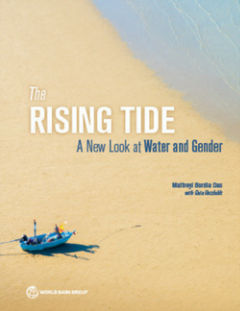'The Rising Tide: A New Look at Water and Gender' Report by WB
Published on by Water Network Research, Official research team of The Water Network in Government
World Bank report “The Rising Tide: A New Look at Water and Gender” provides a fresh look at the relationship between water and gender.

As Senior Director of the World Bank Water Global Practice Guangzhe Chen says: “We believe this report will help those who want to advance social inclusion in water, close gender gaps, and lift those who all too often are left behind or left out. “
For the World Bank, water and gender equality is a vital issue. The Sustainable Developments Goals provide both an ambitious mandate and ambitious targets. A new World Bank Gender Strategy raises the bar for our own work. And the World Bank Water Global Practice have recently launched a new partnership for water security and sanitation.
The Rising Tide builds on a previous World Bank report on social inclusion and tells us that water is an asset, a service, and a space. That’s because water has distinct economic as well as noneconomic and nonmonetary values. Some values are spiritual or social and the underlying norms and practices that play out are often deeply gendered. Informal institutions, taboos, rituals, and norms all play a part in cementing the status quo.
The Rising Tide shows how water often reflects, and even reinforces, gender inequality. As Caren Grown, Senior Director Gender, at the World Bank explains in the foreword of the report: “(The report shows us that) water is an arena where gender relations play out in ways that often mirror inequalities between the sexes. And it examines how norms and practices related to water often exacerbate ingrained gender and other hierarchies.”
This relationship between water and gender often plays out in unexpected ways. For example, not all women are disadvantaged, nor all men privileged. For example, we know that women are disproportionately responsible for fetching and managing household water. But the report also points out that women’s and girls’ relationship with bodies of water is often quite different from that of men and boys. In developing countries, for instance, the former are less likely to be taught to swim. However, men are also more likely to die of drowning than women.
Since water is a site where gender relations play out, interventions that balance these relations in water-related domains can have a strong influence on furthering gender equality more broadly.
The report shows that noneconomic values of water are important for policy and practice. It describes how they influence the behavior of individuals and groups, particularly their response to water-related reforms or interventions. This means that policies and programs have huge potential to drive and shape change.
Read full article: World Bank
Report available in the attachment
Credits:
Das, Maitreyi Bordia. 2017. “The Rising Tide: A New Look at Water and Gender.” World Bank, Washington, DC.
© 2017 International Bank for Reconstruction and Development / The World Bank
Media
Taxonomy
- Drinking Water Security
- Gender Equality
- Sanitation
- Water & Sanitation
- Gender Rights
- Sanitation & Hygiene
- Sanitation & Hygiene
- Drinking Water Managment
- Drinking Water
- Water Sanitation & Hygiene (WASH)